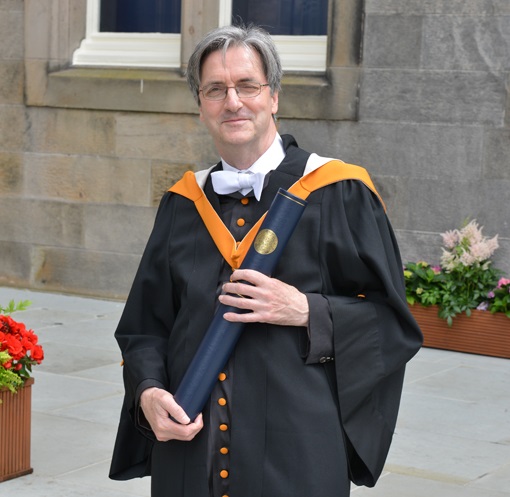Laureation address: Sir Nicholas Penny

Laureation by Dr Julian Luxford
School of Art History
Chancellor, it is my privilege to present Sir Nicholas Penny for the degree of Doctor of Letters, honoris causa.
Sir Nicholas Penny is the current Director of the National Gallery in London, a post he has occupied since 2008. He is a modest individual, but this podium is not the place to spare anyone’s blushes. In any case, in lauding him as an enlightened, sympathetic and effective advocate of Britain’s artistic patrimony, I do no more than state a basic truth.
As all who know him agree, it is the thoroughness of his erudition that makes him a truly outstanding curator and manager. His scholarly work began at the Courtauld Institute of Art in London, where he received his PhD in 1975, and has always been characterised by exceptional breadth. In the past thirty-five years he has written and edited some twenty books on subjects ranging from Renaissance painting and sculpture to the twentieth-century artist Lucian Freud. His two catalogues of the sixteenth-century paintings in the National Gallery in London, published in 2004 and 2008 respectively, are exemplars of their type. Hyperbole and jargon-free, they represent the best of recent art historical scholarship.
All of this has been achieved in the course of a brilliant academic and curatorial career. After obtaining his doctorate, Dr Penny was a lecturer in Art History at the University of Manchester. From there he went on to his first museum position, as Keeper of the Department of Western Art at the Ashmolean Museum in Oxford, after which – from 1990 to 2000 – he was Clore Curator of Renaissance Painting at the National Gallery in London. He then took up the post of Andrew W Mellon Professor at the Center for Advanced Study in the Visual Arts at the National Gallery of Art in Washington DC, where he was Senior Curator of Sculpture and Decorative Arts from 2002 until his return to London in 2008. As such he has been, and is, a true public servant of the arts.
It is in his capacity of public servant that Scotland has particular reason to thank him. Over the past several years, Dr Penny has played an instrumental role in ensuring that a group of outstanding loans from the Bridgewater Collection can remain on display at the National Gallery of Scotland in Edinburgh, where they have been since 1945. This, one of the most important of all private collections of Old Master paintings, includes two Raphaels, four Titians, a Rembrandt self-portrait and no fewer than eight works by Poussin. Two of the paintings by the Venetian sixteenth-century master Titian – the Diana and Acteon and the Diana and Callisto – were the greatest Italian Renaissance pictures in private hands anywhere in the world before they were bought for the nation through the joint efforts of the National Galleries in London and Edinburgh. Nicholas Penny’s personal role in securing them, and with them the ongoing loan to Edinburgh of the rest of the Bridgewater paintings, was in the words of a colleague ‘hugely significant’. By itself, this practical service to the public and the nation has earned Dr Penny the gratitude of all who enjoy these remarkable paintings, now and in the future.
I might add as a footnote that Dr Penny’s services to the Arts were recognized in this year’s Queen’s birthday honours list with the award of a knighthood.
Chancellor, in recognition of his major contribution to the history and custodianship of art, I invite you to confer on Sir Nicholas Penny the degree of Doctor of Letters, honoris causa.
Category Awards